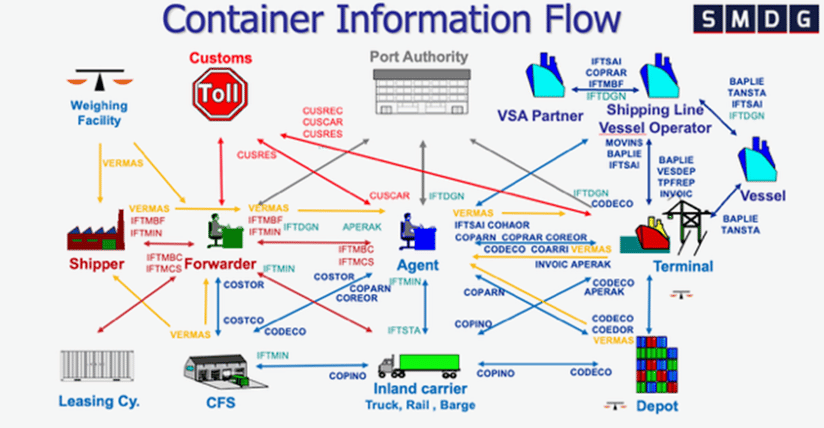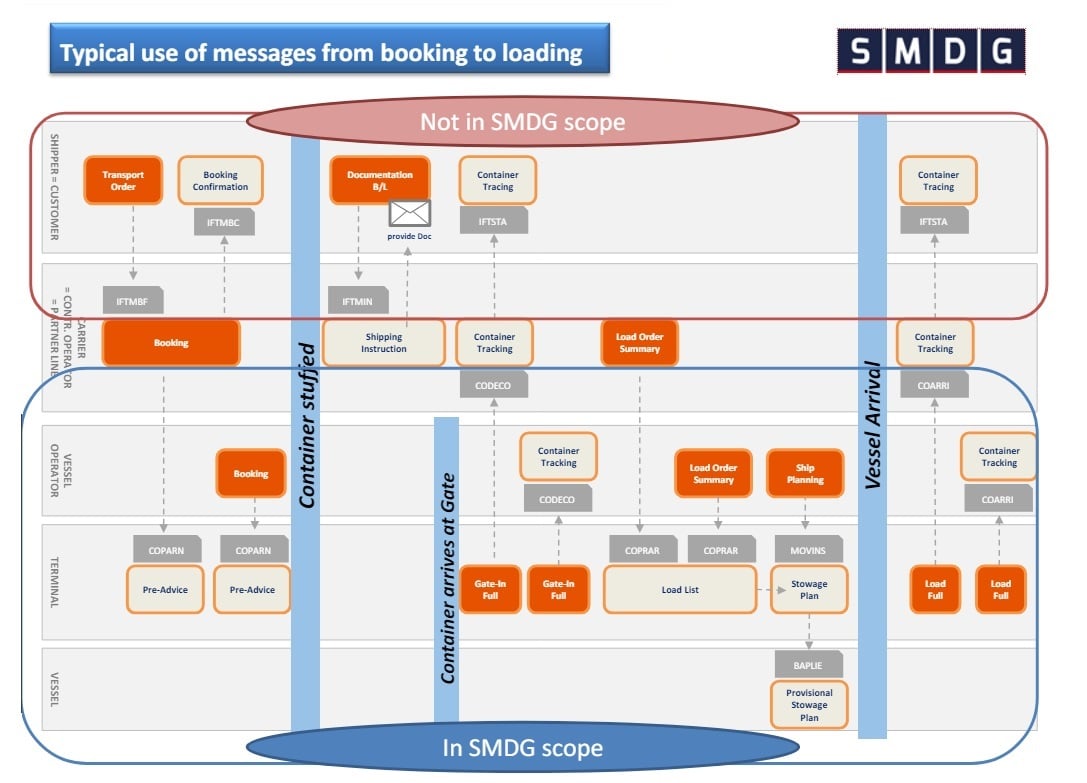According to UNCTAD, over 80% of the volume of international trade in goods is carried by sea. This fact not only underscores the essential role of the maritime transportation sector in global trade, but also indicates the importance of seamless data exchange among stakeholders of the ocean shipping domain.
To drive efficiency in the wider maritime industry and within the container freight business in particular, standardizing the exchange of messages is paramount. One of the organizations that stands as a critical contributor in this regard is the Ship Message Design Group (SMDG). This association has been shaping and upholding the digital messaging standards underpinning the industry's core operations for more than 30 years.
In this article, we will delve into the significance of digital message standardization, the role of the SMDG in this context, and the tangible benefits that companies derive from adhering to these kinds of standards.
Understanding EDI and the Importance of Digital Message Exchange Standardization
Electronic Data Interchange (EDI) emerged in the early 1970s. This process aimed to facilitate the exchange of business-critical data and documents in a structured, electronic format to reduce errors, eliminate the need for manual data entry, and streamline communication between trading partners. Over the years, EDI has become the primary tool for business communications for numerous businesses, particularly those operating in the domain of ocean logistics. However, despite its widespread use and popularity, a notable challenge persists: the absence of knowledge about the existing EDI standards as well as unclear guidelines on how to correctly implement those.
Standardization in EDI refers to establishing uniform formats, codes, and protocols that enable seamless communication across diverse systems. This standardization is vital for fostering interoperability, reducing complexity, and ensuring a common language for data exchange. Conversely, neglect of the standards or lack of “How to” knowledge can lead to a scenario in which industry stakeholders must deal with numerous variations and dialects of the messages being exchanged, which often results in inefficiencies and, to some extent, poses safety risks.
With all the API buzz happening within the industry, one may wonder: why stick with EDI? Why not switch to modern APIs instead of dealing with the old-fashioned and cumbersome approach of EDI?
This question often emerges because stakeholders encounter countless variations, or better to say, interpretations of the proposed EDI standards. Should this happen to APIs, we will likely see the same complaints. Nowadays, APIs are mostly used to retrieve master data. Once businesses start using them to their full extent, for instance, to send bookings and discharge lists, the same issues will arise.
Another point to consider when comparing the two is APIs' limitations. Currently, many APIs can only process a maximum of 100 to 300 items in one API request and expect a response to give an answer before going into Timeout, meaning no response at all. So, handling a discharge list of over 1000 containers, which is a common case with all these large vessels, could be cumbersome or even impossible for many systems. Whereas EDI can offer distinct advantages, as it, by design, allows handling large, intricate datasets within a restricted user group and within non-time-sensitive scenarios.
So, if we see EDI as a means of exchanging data electronically in a standardized manner, its relevance becomes apparent, particularly in certain applications, like the one described above.
Ultimately, the EDI standards fulfill crucial roles within the industry, forming the foundation for stakeholders' systems. Over time, these standards may merge with APIs, becoming part of the core message structure. Hence, rather than pitting EDI against APIs, industry stakeholders should embrace both approaches to unlock the benefits of each, bridging the gap between traditional and modern data exchange methodologies.
SMDG: 30 Years of Working in Maritime Data Interchange Standardization
The SMDG, or the Ship Message Design Group, was born out of a need to standardize the EDIFACT message BAPLIE (Bayplan Message - position of containers on a ship) in the late 1980s. Over the years, the SMDG has evolved into a UN/CEFACT-endorsed body recognized for its role in standardizing EDI messages for the maritime industry.
The dual-leadership structure of the SMDG, representing both shipping lines and terminals, ensures a balanced and inclusive approach to standardization. The organization's primary objectives include enabling the exchange of structured data, fostering a common electronic language, and providing quality advice and guidance in the field of EDI.
The SMDG's commitment to neutrality, maintaining non-profit status, and international recognition underscores its dedication to advancing EDI standardization to benefit the entire maritime supply chain.
Today, the standardization efforts of the association go well beyond EDIFACT. In fact, the SMDG would rather foster digital data interchange in general, so, along with continuing to develop EDI standards, the association is gradually stepping into the realm of API to ensure the seamless exchange of data between stakeholders of the sector regardless of which technology they prefer. As a result, the association will continue to bring together companies and organizations involved in maritime logistics, including container terminals, ocean carriers, software providers, and other related entities.

Image 1 – Stakeholders of the SMDG's standardization initiatives.
Despite the wide variety of organizations that benefit from the SMDG’s standardization initiatives, it is vital to note that the SMDG’s scope of work only covers the operational side of the messaging cycle.

Image 2 – Messages that the SMDG covers in regard to the booking-loading message cycle.
Since its establishment in 1987, the SMDG has issued a plethora of recommendations and held numerous international meetings and workshops, where topics include, but are not limited to, standard EDI messages.
As an organization that is deeply committed to upholding standards that ensure the safety of our seas, much of the SMDG's focus revolves around maritime safety initiatives. One such initiative involves the exchange of critical safety-related information, including data concerning Critical and Dangerous Cargo Information and Verified Gross Mass (VGM), within the maritime industry. This crucial topic serves as one of the primary tracks for discussion at the SMDG's upcoming 78th Plenary Meeting, which is scheduled to take place in Antwerp from April 22 to 26, 2024.
Below are a few examples of the SMDG's recent contributions to maritime data interchange standardization:
- Introduction of a new code list (PCACTIVITY) describing planned events in a vessel schedule.
- New recommendations for best practices for EDI transmission of “empty tank containers with residues” have been published.
- The definition of the code lists ATTRIBUTES, HANDLING, and STOWINS that have been combined in a single Excel workbook.
- Several updates of the SMDG Terminal Code List and the SMDG Liner Code List are published per year.
To learn more and get the latest version of the aforementioned documentation, please visit the SMDG's website.
Collaboration for a Cohesive Industry Approach
The SMDG recognizes the importance of collaboration in achieving its goal to establish a comprehensive industry-wide EDI standardization. Thus, the organization actively cooperates with various European and international entities, including UN/CEFACT, PROTECT, DCSA, BIC, ITIGG, EXIS, and EIPP SAB. These collaborations amplify the impact of standardization efforts, aligning the maritime industry with global best practices and facilitating interoperability on a broader scale. Because, overall, global logistics is about connectivity and global shipping is probably the most interconnected industry in the world.
Another way to encourage the acceptance of new standards is to cooperate closely with industry stakeholders, who are, in fact, the beneficiaries of all initiatives. To broaden the collective voice and make it heard worldwide, the SMDG invites all sorts of stakeholders to join its network.
As a result, the SMDG's membership base comprises a diverse range of companies and organizations involved in the maritime container business. Corporate members, including major players like CMA-CGM, Hapag-Lloyd, Kuehne + Nagel, x-press Feeders, Eurogate, and Rotterdam World Gateway, represent a cross-section of the industry. Meanwhile, institutional members, such as BIC and Portbase, contribute expertise and insights to further enhance EDI standardization. And, of course, solution providers and data integrators like Navis and Youredi, who bridge the gap between EDI and API help industry stakeholders take advantage of the benefits of both worlds.
Having representatives from carriers, forwarders, ports, terminals, and solution providers on board ensures that the outcomes of the SMDG’s various initiatives will benefit the industry as a whole.
Benefits of Digital Message Standardization for Companies
Companies that adhere to the SMDG’s standards stand to gain significantly in terms of operational efficiency, cost reduction, and overall competitiveness. For example, some of the benefits include:
- Streamlined Operations: Standardized digital messages ensure a consistent and structured flow of information, reducing the risk of errors and processing delays.
- Improved Accuracy: Common data formats and codes eliminate ambiguity and enhance data accuracy, fostering reliable communication between different stakeholders in the supply chain.
- Cost Reduction: The automation enabled by standardized processes leads to cost savings by reducing the need for manual labor and the involvement of IT specialists, decreasing error correction expenses, and optimizing resource utilization.
- Enhanced Decision-Making: Standardized message exchanging processes provide better visibility into the movement of goods, enabling better decision-making and responsiveness to changing conditions.
- Global Interoperability: Adherence to international EDI or other industry standards, as facilitated by SMDG, ensures compatibility with global trading partners, fostering seamless collaboration on a global scale.
- Operational Efficiency: Standardization results in streamlined processes, reducing redundancy and enhancing the overall efficiency of maritime operations.
- Safety Enhancement: By leveraging standardized process and messages, companies can establish clear and consistent communication protocols, reducing the likelihood of safety incidents and improving overall operational safety.
In this article, we tried to outline the significance of digital message standardization efforts and show the importance of EDI as a way for industry stakeholders to exchange business-critical data. Given its status as an integral component of the global trade landscape, Electronic Data Interchange (EDI), despite its imperfections and complexities, is unlikely to fade away anytime soon. Instead, it might even become a cornerstone for the active development of the APIs that are so popular within the industry nowadays.
Recognizing this, initiatives for standardization become pivotal, serving as a foundation for efficiency, safety, and interoperability within the maritime container business. In this realm, the SMDG stands out as a key player, actively shaping the future of the industry.


